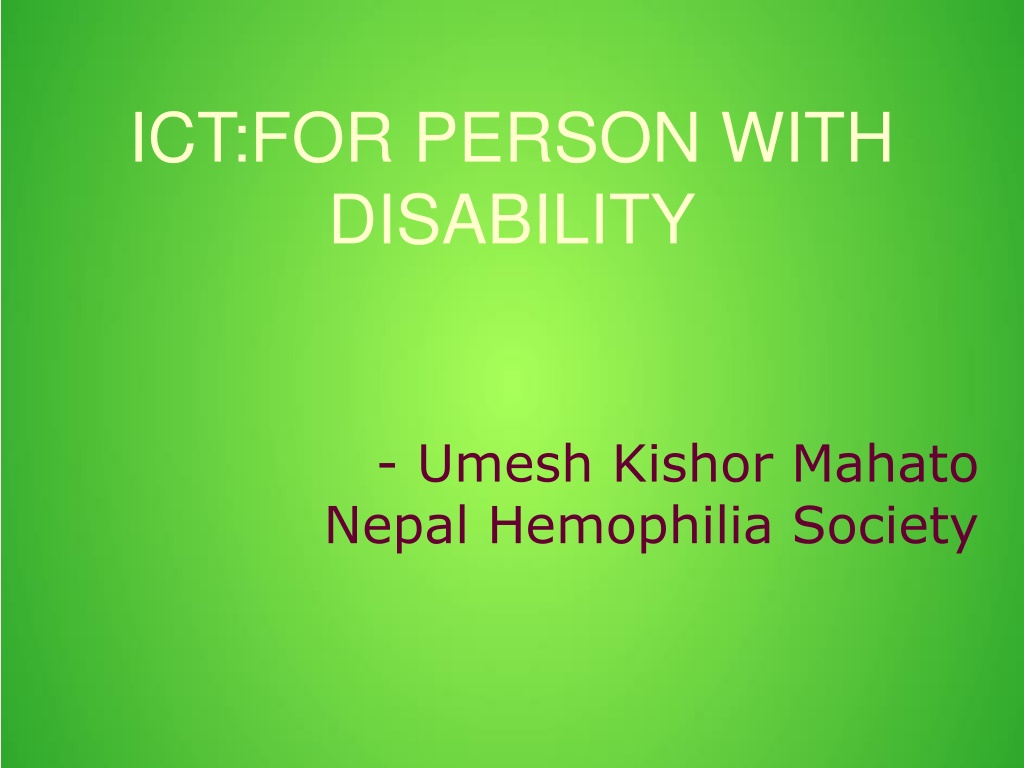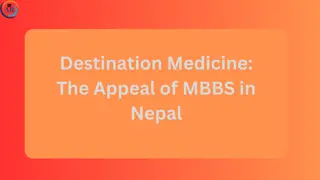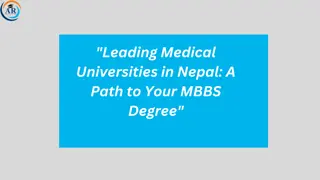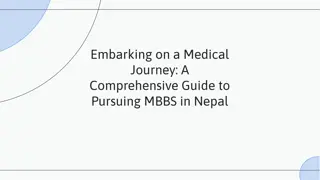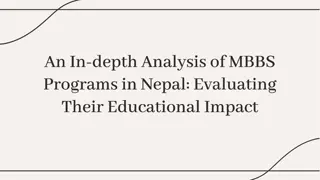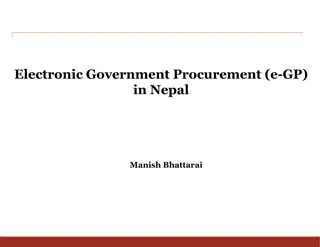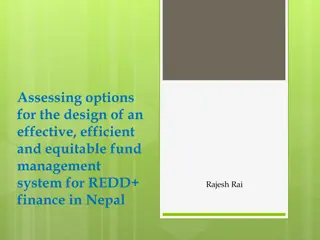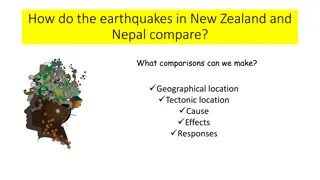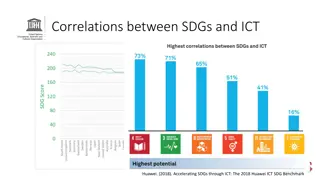ICT for People with Disability in Nepal
Information and Communication Technology (ICT) plays a crucial role in empowering individuals with disabilities by providing access to information, communication, and services. Despite obstacles such as geographical limitations and affordability issues, developing ICT specifically tailored for different categories of persons with disabilities, like those with hemophilia, can enhance accessibility and support their educational and healthcare needs. Online platforms, discussion forums, and specialized apps can offer valuable resources and support for individuals facing challenges due to their disabilities, such as hemophilia.
Download Presentation

Please find below an Image/Link to download the presentation.
The content on the website is provided AS IS for your information and personal use only. It may not be sold, licensed, or shared on other websites without obtaining consent from the author.If you encounter any issues during the download, it is possible that the publisher has removed the file from their server.
You are allowed to download the files provided on this website for personal or commercial use, subject to the condition that they are used lawfully. All files are the property of their respective owners.
The content on the website is provided AS IS for your information and personal use only. It may not be sold, licensed, or shared on other websites without obtaining consent from the author.
E N D
Presentation Transcript
ICT:FOR PERSON WITH DISABILITY - Umesh Kishor Mahato Nepal Hemophilia Society
What is ICT? Information-(or data) in paper or electronic formate. Communication-in person or electronically(electronic communication),in writing or voice,telecommunication,and broadcasting. Communication technology- including software,hardware and electronics.
What is ICT?. Information is power and key to progress. It is an important resource for people to take decisions about machine ,money and materials in terms of production in any organization. Similarly communication is the activity of exchange of meaningful information among concerned people. In other words,it is the transmission of idea(message) from one person to another person using proper channel to get proper feedback.
What is ICT?... Technology is the set of various techniques,skills,methods,and processes to produce goods and services. It helps in scientific investigation for the development of machine,computers,factories,devices and the like. With the integration of information,communication and technology,ICT is formed. Some examples of ICTs are Radio,Tv,Telephone,Newspaper,,Computer,vi deo conference,e-classes,tutorial CD/DV etc.
Obstacles for using ICT by disabled person. Geographical-there is no internet connectivity in all rural region of Nepal. There is no accessibility to all pwds. All pwds can not afford to use ICT materials as needed. ICT is not accessible to all pwds We don t have ideas about any kinds ICT materials launched by government of Nepal.
ICT should be developed for different categories of pwds For hemophilia Person with hemophilia might not be able to attend the class or work on occasions due to bleeding episodes.so online platform where teacher shares the days teaching marerials. It should discussion forum too where pwh can post his query/question.such queries can be answered by teacher or other students too.
Continued...for hemophilia App telling pwhs where/which hospitals does provide hemophilia specific services. MOH to run an app answering FAQs(frequently asked questions) like factor availability,cost of factor,types of physiotherapy which can help PWHs,sign and symptoms of hemophilia.
For blind or vision impairment disability. Should be develop TTS Should be develop book reader as free of cost. For intellectual disability. Should be develop smart curriculum. Should be develop easy to read software. Should develop a software to cario typing test Should be develop communicating tools Should develop apps that help in legal procedure
What is hemophilia? It is a genetic disorder. It is usually inherited. It cannot be caught or transmitted except through inheritance. It is having a low level or absence of one of the clotting factors in the blood.
What is hemophilia? The lack of clotting factor causes people with hemophilia to bleed for longer periods of time than people whose blood factor levels are normal. People with hemophilia do not bleed faster than other people, and will not bleed to death from a minor cut or injury. The main problem for people with hemophilia is bleeding internally, mainly into muscles and joints.
What are the signs of hemophilia? Big bruises Bleeding into muscles and joints, especially the knees, elbow, and ankles Spontaneous bleeding (sudden bleeding inside the body for no clear reason) Bleeding for a long time after getting a cut, removing a tooth, or having surgery Serious internal bleeding into vital organs, most commonly after a serious trauma
Slide No. Footer Effects of bleeding 1) Joint damage 2) Chronic Synovitis 3) Neuropathy 4) Compartmental Syndrome 5) Tumour 6) Deformity 7) Handicapped 8) Reduced quality of life
1)Group members Umesh Kishor Mahato (Nepal hemophilia society.) Bharat Khadka (Nepal hemohilia society) Amara Aryal (women group for disability right) Pratiksha Bhattarai (Blind women association) Shrijana k.c. (Mother society of intellectual disability) 1)
